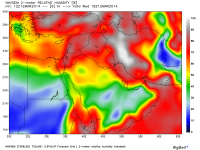olar Update / M2.5 Flare
Good morning. Below is an updated image of the visible solar disk on Wednesday. Solar activity continues at moderate levels. Sunspot 1996 produced an M2.5 solar flare peaking at 11:05 UTC (see image below). The active region continues to rotate closer towards the west limb and will soon begin to rotate out of direct Earth view. Future eruptions around this region will likely be directed away from our planet. In the southern hemisphere, sunspot 2002 is now located in a geoeffective position. During the past 24 hours it has only managed C-Class flares, including a C9.7 at 16:27 UTC. Both regions will remain a threat for additional M-Class flare events. New sunspot 2005 was numbered after rotating into view off the east limb and appears to be stable. This region, or at least what is left of it, was the source of a strong farsided solar flare on March 5th. All other visible regions remain quiet.
Good morning. Below is an updated image of the visible solar disk on Wednesday. Solar activity continues at moderate levels. Sunspot 1996 produced an M2.5 solar flare peaking at 11:05 UTC (see image below). The active region continues to rotate closer towards the west limb and will soon begin to rotate out of direct Earth view. Future eruptions around this region will likely be directed away from our planet. In the southern hemisphere, sunspot 2002 is now located in a geoeffective position. During the past 24 hours it has only managed C-Class flares, including a C9.7 at 16:27 UTC. Both regions will remain a threat for additional M-Class flare events. New sunspot 2005 was numbered after rotating into view off the east limb and appears to be stable. This region, or at least what is left of it, was the source of a strong farsided solar flare on March 5th. All other visible regions remain quiet.



















